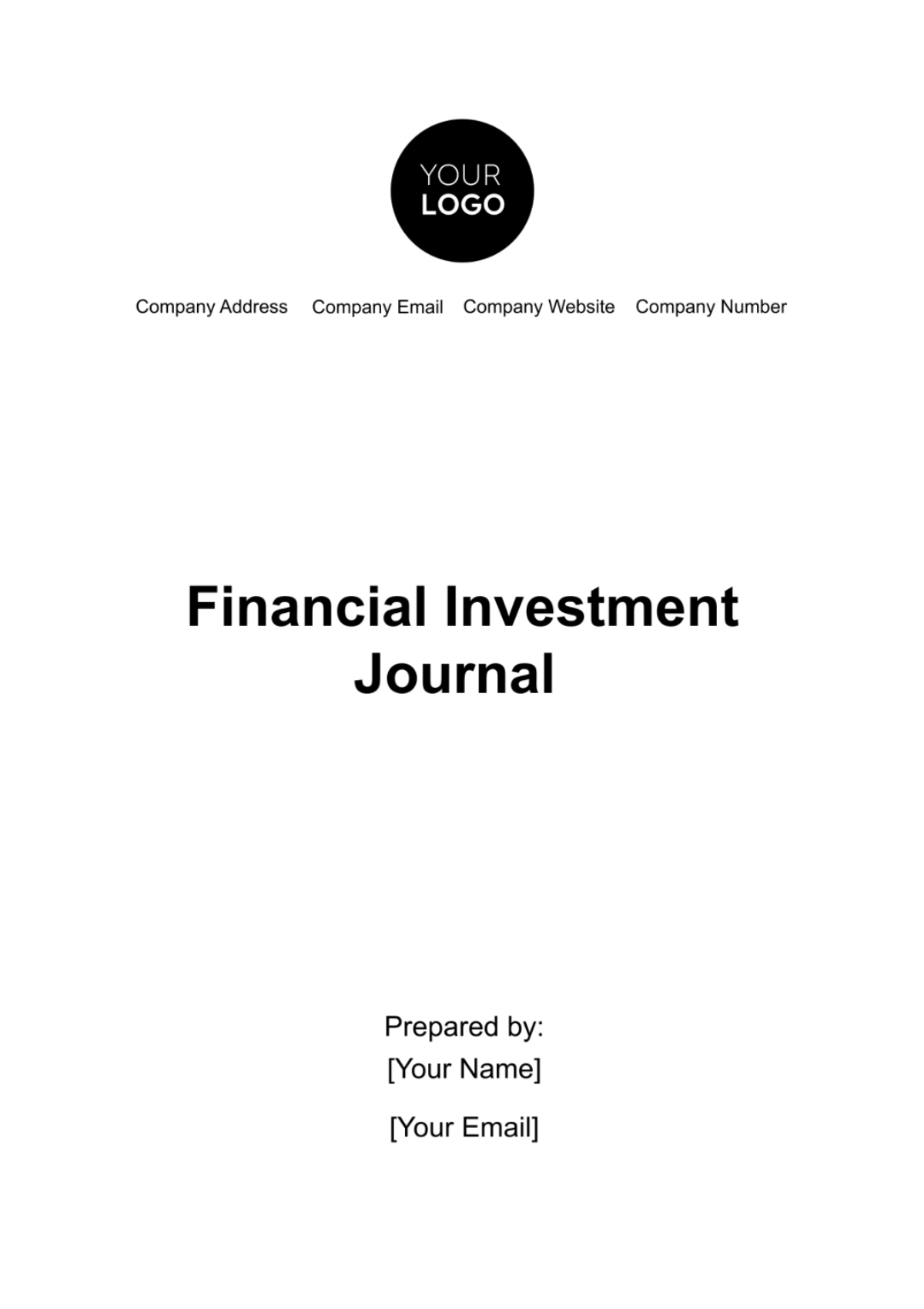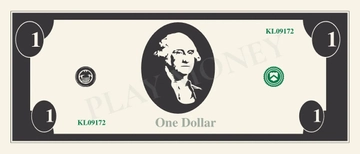Free Financial Investment Journal

Introduction
This journal offers a detailed exploration of our company's financial investment strategies and portfolio management, aiming to achieve an optimal balance between risk and return. In an ever-changing economic environment, our focus is on adapting to market dynamics to maximize profitability while safeguarding our assets. This document presents a comprehensive analysis of market trends, portfolio performance, and strategic direction, serving as a guide for stakeholders in understanding our financial decision-making process.
Market Overview
Economic Indicators
We begin by examining key economic indicators, which provide a foundational understanding of the current financial landscape:
Gross Domestic Product (GDP) Growth: The global GDP growth rate currently stands at a steady 3.5%, indicating a stable economic environment favorable for investment.
Inflation Rates: With a moderate inflation rate of 2.2%, the market environment remains conducive to long-term investment strategies.
Unemployment Rates: A current unemployment rate of 4.5% suggests a recovering job market, which could lead to increased consumer spending and corporate earnings.
Consumer Spending Trends: There is a noticeable uptick in consumer spending, particularly in technology and sustainable products, reflecting growing consumer confidence.
These indicators help us in formulating a robust investment strategy that aligns with current economic conditions.
Sector Analysis
Our sector analysis focuses on identifying growth sectors and potential risks:
Technology: The technology sector shows an annual growth rate of 10%, driven by advancements in artificial intelligence and cloud computing.
Healthcare: With an aging population and technological advancements, the healthcare sector is expected to grow by 8% annually.
Energy: The shift towards renewable energy is creating volatility in traditional energy markets, but presenting opportunities in green technology.
Consumer Goods: The consumer goods sector is experiencing a modest growth of 5%, influenced by changing consumer preferences towards sustainable products.
Global Market Trends
We incorporate global trends into our analysis for a comprehensive investment approach:
Emerging Markets: Emerging markets are showing promising growth, with an average GDP increase of 6%, offering lucrative investment opportunities with higher risk.
Currency Fluctuations: Recent stabilization in major currencies has reduced the foreign exchange risk for international investments.
Economic Indicator | Current Trend | Implications for Investments |
GDP Growth | 3.5% | Positive, conducive for growth-oriented investments |
Inflation Rate | 2.2% | Stable, favorable for long-term investments |
Unemployment Rate | 4.5% | Decreasing, positive for consumer-related sectors |
Consumer Spending | Increasing | Positive, especially in tech and sustainable products |
This table provides a snapshot of the current economic indicators and their implications for our investment strategies.
Market Risks and Opportunities
Geopolitical Events: Ongoing trade negotiations between major economies could impact global market stability; we are monitoring these developments closely.
Regulatory Changes: Anticipated regulatory reforms in the technology and finance sectors could present both challenges and opportunities for our portfolio.
Portfolio Analysis
Our portfolio is structured to balance risk and return, leveraging diversification across various asset classes. We continually assess and realign our investments in response to market changes and company objectives.
Asset Allocation
The current allocation of our portfolio is strategically diversified to optimize returns while managing risk effectively.
Equities: Comprise 50% of our portfolio, focusing on high-growth technology and healthcare stocks.
Fixed-Income Securities: Account for 30%, with a mix of government and high-grade corporate bonds.
Real Estate and Alternatives: Make up 15%, including commercial real estate and renewable energy projects.
Cash and Equivalents: The remaining 5% is held in cash and cash equivalents, providing liquidity and safeguarding against market volatility.
Performance Review
Our performance review provides a breakdown of returns and risk across different asset classes.
Asset Class | Investment | ROI (%) | Risk Level |
Equities | $50 million | 12% | High |
Fixed-Income | $30 million | 5% | Low |
Real Estate | $15 million | 8% | Medium |
Cash and Equivalents | $5 million | 1% | Very Low |
The equities segment, while carrying higher risk, has shown the highest returns, particularly in the technology sector.
Fixed-income securities provide stable, though lower, returns, acting as a buffer in market downturns.
Real estate investments offer moderate returns and serve as a hedge against inflation.
Investment Strategies
Our investment strategies are designed to achieve long-term growth, income generation, and capital preservation, adapting to changing market conditions and investment opportunities.
Equity Investments
Stock Selection Criteria
Market Capitalization: Preference for large-cap stocks known for stability and mid-cap stocks for growth potential.
Price-to-Earnings Ratio: Stocks with reasonable P/E ratios compared to industry averages are selected.
Dividend Yield: Stocks offering attractive dividend yields are included for income generation.
Portfolio Diversification
Geographical Diversification: Investments are spread across various global markets to reduce region-specific risks.
Sectoral Diversification: Exposure across multiple sectors, with a focus on technology, healthcare, and consumer goods.
Fixed-Income Investments
Bond Portfolio
Government Bonds: Comprise a significant portion of the bond portfolio, offering low risk and stable returns.
Corporate Bonds: Selected high-grade corporate bonds for higher yields with controlled risk.
Credit Risk Management
Credit Quality Analysis: Regular assessment of bond issuers' creditworthiness to manage default risk.
Duration Strategy: Employing a duration strategy to mitigate interest rate risk.
Alternative Investments
Real Estate
Commercial Properties: Investment in high-value commercial properties in urban areas for steady rental income and capital appreciation.
Green Energy Projects: Investments in renewable energy projects align with our commitment to sustainability and offer potential tax advantages.
Other Alternatives
Commodities: Limited exposure to commodities like gold as a hedge against inflation.
Private Equity: Selective investments in private equity for potential high returns, albeit with higher risk.
Risk Management in Investments
Diversification: The primary tool for risk management, spreading investments across asset classes and sectors.
Hedging Strategies: Use of derivatives to hedge against market volatility, particularly in our equity investments.
Risk Management
Effective risk management is a cornerstone of our investment philosophy, ensuring the sustainability and growth of our portfolio over the long term. We employ a multifaceted approach to identify, assess, and mitigate risks.
Risk Assessment
We continuously monitor various risks that could impact our investments:
Market Risk: The risk of loss due to market fluctuations.
Credit Risk: The risk of loss due to an issuer's inability to meet principal and interest payments.
Liquidity Risk: The risk that an investment cannot be sold at its fair market value.
Operational Risk: The risk of loss resulting from inadequate or failed internal processes.
Our risk assessment framework employs quantitative measures such as Value at Risk (VaR), Beta, and standard deviation to quantify these risks.
Mitigation Strategies
Our strategies for mitigating identified risks include:
Diversification: Spreading investments across various asset classes, sectors, and geographies to reduce exposure to any single risk factor.
Hedging: Using derivatives like options and futures to protect against market downturns, particularly in our equity portfolio.
Quality Focus: Investing in high-quality assets with strong fundamentals to withstand economic downturns.
Liquidity Management: Maintaining a portion of our portfolio in liquid assets to meet short-term obligations and capitalize on new investment opportunities.
Risk Type | Mitigation Strategy |
Market Risk | Diversification, Hedging |
Credit Risk | Quality Focus, Diversification |
Liquidity Risk | Liquidity Management, Diversification |
Operational Risk | Process Improvement, Compliance |
This table outlines the primary risks to our portfolio and the corresponding strategies to mitigate them.
Future Outlook
Our future outlook is shaped by both global economic trends and company-specific objectives. We remain vigilant and adaptable to navigate the evolving investment landscape.
Investment Opportunities
Emerging Markets: We see continued growth potential in emerging markets, particularly in Asia and Africa.
Technological Innovations: Sectors like AI, biotechnology, and renewable energy are poised for significant growth.
Sustainable Investments: With increasing focus on sustainability, investments in green energy and sustainable practices offer both profitability and alignment with corporate responsibility.
Strategy Adjustments
Geopolitical Monitoring: Keeping a close eye on geopolitical developments to preemptively adjust our strategies in response to global events.
Regulatory Changes: Staying abreast of regulatory changes, especially in tech and finance sectors, to mitigate risks and exploit new opportunities.
Strategic Focus | Rationale |
Emerging Markets | High growth potential, diversification |
Technology Sector | Innovation-driven growth |
Sustainable Investments | Corporate responsibility, profitability |
This table highlights the key areas of strategic focus for our future investments, underpinned by our analysis of market trends and company goals.
- 100% Customizable, free editor
- Access 1 Million+ Templates, photo’s & graphics
- Download or share as a template
- Click and replace photos, graphics, text, backgrounds
- Resize, crop, AI write & more
- Access advanced editor
Track your investment journey meticulously with Template.net's Financial Investment Journal Template. This editable, customizable journal allows for detailed recording of investment activities and insights. An essential tool for individual investors, it helps in monitoring investment progress, reflecting on decisions, and planning future moves based on personal experience and market trends.





























